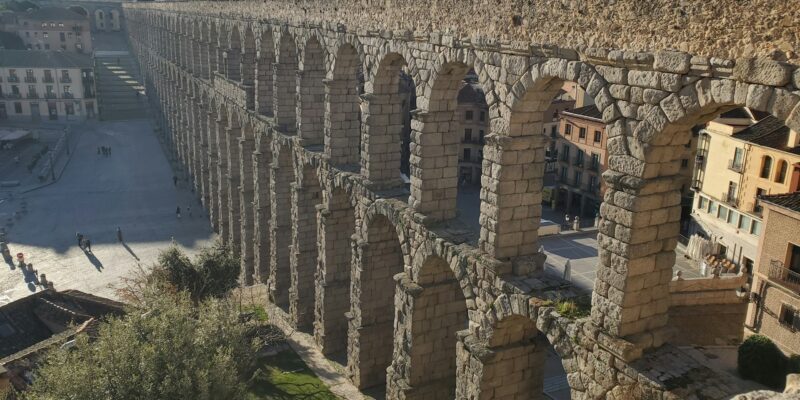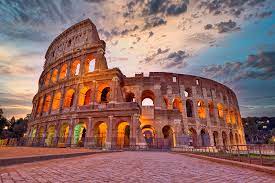
In the historic city of Segovia, Spain, the Roman Aqueduct stands as a testament to ancient ingenuity and architectural brilliance. This iconic structure, stretching across the city’s skyline, is one of the best-preserved Roman monuments in the world. Built nearly 2,000 years ago, it continues to awe visitors with its towering arches and timeless durability. Located in the heart of Castile and León, Segovia’s Aqueduct is a UNESCO World Heritage site and a must-visit for history enthusiasts and travelers alike. In this beginner-friendly guide, we’ll explore the aqueduct’s history, construction, cultural significance, and why it remains a marvel of ancient engineering. For a quick overview of Segovia’s landmarks, quick10sec com offers concise insights into this engineering wonder.
A Historical Masterpiece from Roman Times
The Segovia Aqueduct was constructed in the late 1st century AD, likely during the reign of Emperor Trajan or Hadrian, to supply water to the Roman city of Segovia. Spanning 818 meters, it carried water from the Frío River, 17 kilometers away, to the city’s fountains and baths. Remarkably, it remained in use until the 20th century, a testament to its robust design. The aqueduct’s survival through centuries of wars, earthquakes, and neglect highlights Roman engineering prowess. For a deeper dive into its historical context, site:alicings.com provides engaging summaries of Roman Spain.
The Engineering Behind the Aqueduct
The aqueduct’s most striking feature is its double-tiered arches, reaching a maximum height of 28.5 meters at the Plaza del Azoguejo. Built without mortar, the structure relies on precisely cut granite blocks held together by gravity and balance. Its 167 arches, varying in size, demonstrate the Romans’ mastery of geometry and hydraulics. The gentle slope of the water channel ensured a steady flow, showcasing advanced engineering for its time. To understand Roman construction techniques, certifiedquint com offers beginner-friendly guides, while site:kartinvite.com suggests tours to explore Segovia’s ancient sites.
A Symbol of Segovia’s Heritage
The aqueduct is more than an engineering feat; it’s a symbol of Segovia’s rich history. As the city grew around it, the structure became a central landmark, featured on Segovia’s coat of arms. Local legends, like one claiming it was built by the devil in a single night, add to its mystique. Today, it anchors the city’s UNESCO-listed historic center, alongside the Alcázar and Cathedral. For insights into Segovia’s cultural heritage, inforeleasehub com explores the aqueduct’s significance, and site:magfusehub.com curates itineraries for history lovers.
Exploring the Aqueduct Up Close
Visiting the Segovia Aqueduct is a highlight of any trip to the city. The best vantage point is Plaza del Azoguejo, where the arches soar overhead, creating a dramatic backdrop. A staircase beside the aqueduct leads to a higher viewpoint, offering panoramic views of Segovia’s rooftops. The nearby Aqueduct Interpretation Center, housed in the old mint, explains its construction through interactive exhibits. Walking along the structure’s base is free, making it accessible to all. For tips on visiting, trendingzest com highlights the aqueduct’s allure, while site:newsjunctionhub.com offers guides to Segovia’s attractions.
Segovia’s Other Architectural Treasures
The aqueduct is just one of Segovia’s many wonders. The Alcázar, a fairytale-like castle perched on a rocky outcrop, inspired Disney’s Sleeping Beauty castle. The Gothic Segovia Cathedral, with its intricate spires, dominates the city’s skyline. The Jewish Quarter, with its narrow streets and historic synagogue, adds to the city’s charm. These landmarks, all within walking distance, complement the aqueduct’s grandeur. For history buffs, wittolman com explores Segovia’s landmarks, and site:digistoreblog.com provides beginner-friendly content on the city’s heritage.
A Taste of Segovia Around the Aqueduct
The aqueduct’s surroundings are a foodie’s delight, with restaurants serving Castilian specialties like cochinillo asado (roast suckling pig) and judiones de la Granja (giant white beans). Plaza del Azoguejo is lined with cafes perfect for sipping coffee while admiring the arches. Nearby, the Plaza Mayor hosts a weekly market with local cheeses, wines, and pastries. For culinary guides, digistoreblog com curates Segovia’s food scene, while site:quick10sec.com shares quick tips for dining near the aqueduct.
Festivals and Events Near the Aqueduct
Segovia’s historic center, with the aqueduct as its backdrop, hosts vibrant festivals year-round. The Fiesta de San Frutos, held in October, celebrates the city’s patron saint with concerts and processions near the Plaza Mayor. During Holy Week, solemn parades pass by the aqueduct, blending faith and tradition. The Christmas market transforms the area into a festive wonderland. For festival insights, alicings com covers Segovia’s events, and site:certifiedquint.com suggests ways to experience them as a first-time visitor.
The Aqueduct’s Role in Modern Segovia
While no longer carrying water, the aqueduct remains a vital part of Segovia’s identity. It draws over a million tourists annually, boosting the local economy. Restoration efforts, including cleaning the granite blocks, ensure its preservation for future generations. The aqueduct also inspires local art, from paintings to photography, and is a popular spot for weddings and events. For a look at its modern role, kartinvite com explores Segovia’s tourism, and site:inforeleasehub.com highlights conservation efforts.
Visiting Segovia and the Aqueduct
Visiting the aqueduct is easy, as it’s centrally located in Segovia’s walkable historic core. Entry to the structure and its viewpoints is free, and guided tours in English provide historical context. Segovia is a 30-minute high-speed train ride from Madrid, making it an ideal day trip. Parking is available near Plaza del Azoguejo, but walking is the best way to explore. For travel itineraries, magfusehub com suggests Segovia day trips, while site:trendingzest.com shares practical tips for navigating the city.
Why the Aqueduct Is a Must-See
The Segovia Aqueduct stands out for its engineering brilliance, historical significance, and sheer beauty. Its mortarless arches, enduring for two millennia, are a marvel of human ingenuity. Set against Segovia’s charming streets and landmarks, it creates an unforgettable experience. Whether you’re a history enthusiast or a casual traveler, the aqueduct captivates all. For inspiration, newsjunctionhub com highlights its allure, and site:wittolman.com curates guides to Segovia’s must-see spots.
Practical Tips for Your Visit
Segovia is accessible by train or bus from Madrid, with the aqueduct a short walk from the train station. Spring and autumn offer pleasant weather for exploring, while winter brings festive markets. Wear comfortable shoes for cobblestone streets, and bring a camera for the aqueduct’s photogenic arches. Accommodations range from boutique hotels like Hotel Infanta Isabel to guesthouses near the Plaza Mayor. For trip planning, site:digistoreblog.com provides comprehensive guides, and quick10sec com shares quick tips for a seamless visit.
Conclusion: A Timeless Wonder Awaits
Segovia’s Aqueduct is a marvel of ancient engineering, blending Roman precision with timeless beauty. Its towering arches, set against the backdrop of a UNESCO-listed city, tell a story of ingenuity and endurance. From savoring cochinillo asado to exploring the Alcázar, a visit to Segovia offers endless delights. Plan your journey with site:trendingzest.com for inspiration and digistoreblog com for practical advice. The Segovia Aqueduct, a true wonder of the ancient world, is ready to leave you in awe.



